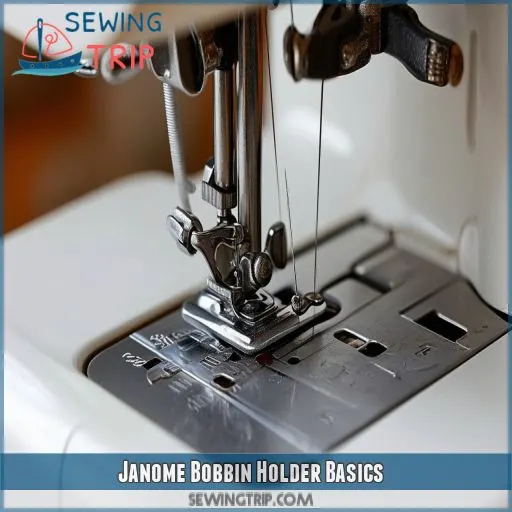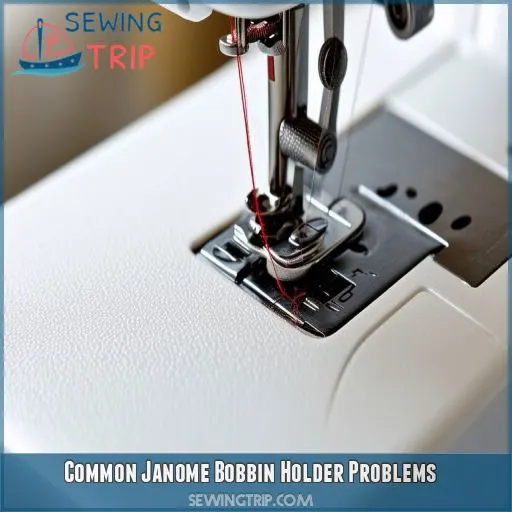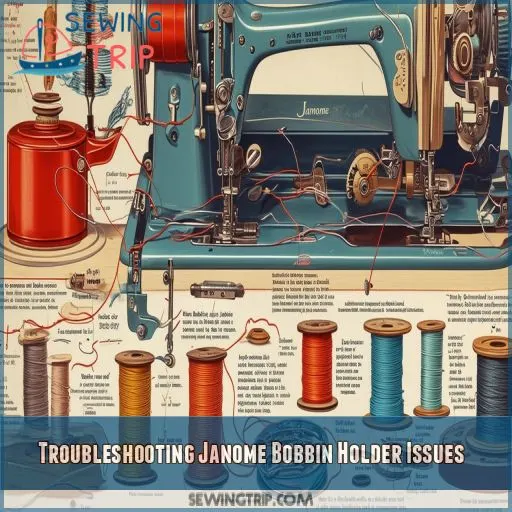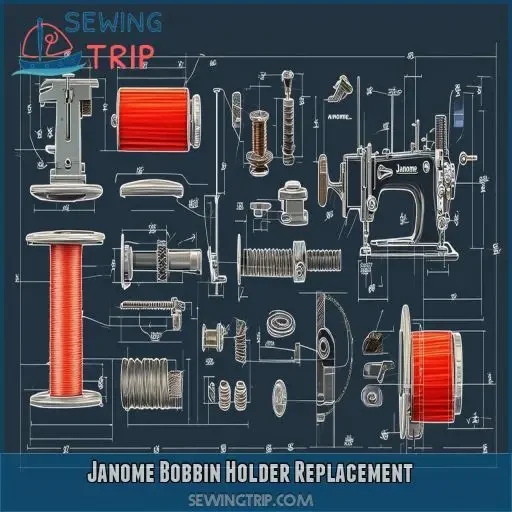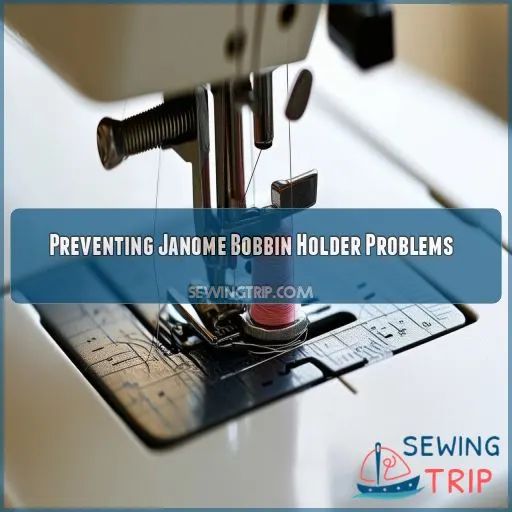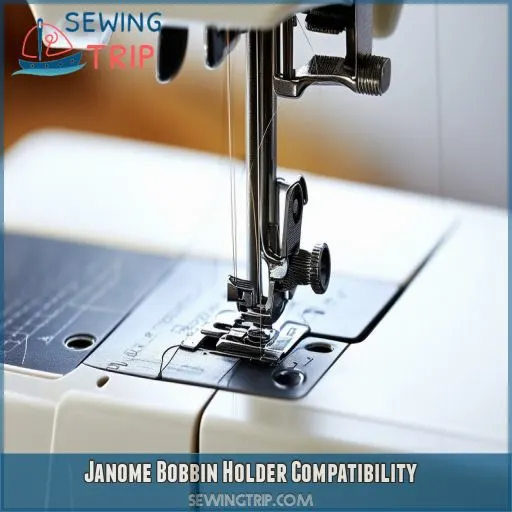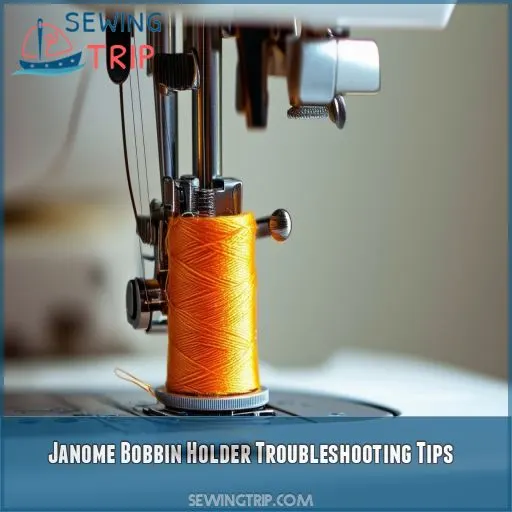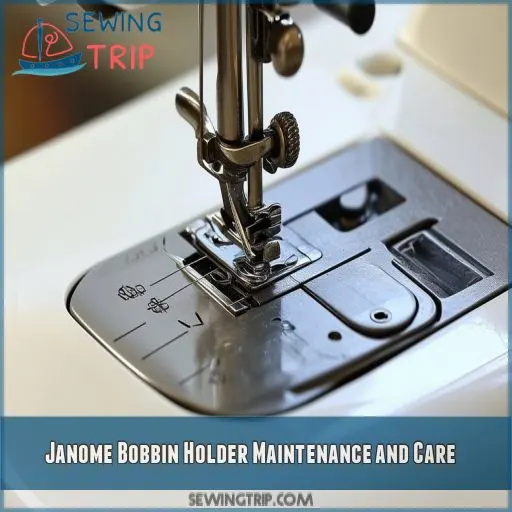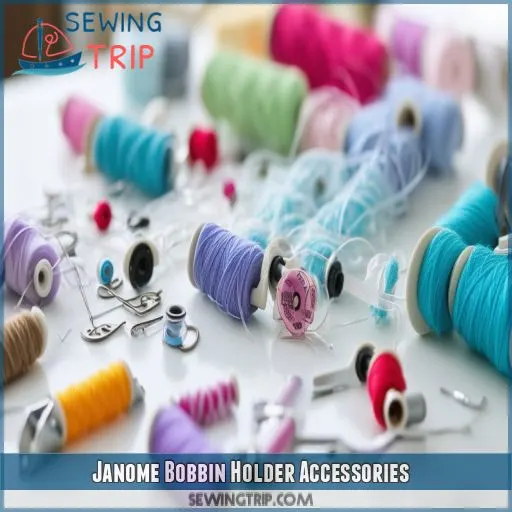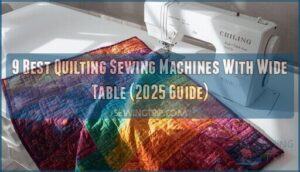This site is supported by our readers. We may earn a commission, at no cost to you, if you purchase through links.
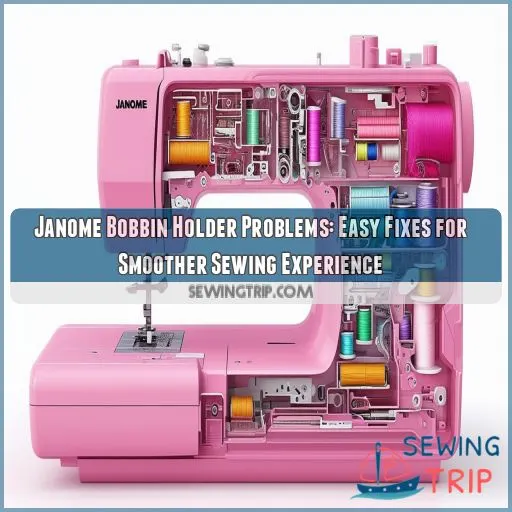
To troubleshoot, first check for lint buildup and clean thoroughly. Lubricate the mechanism and make sure you’re using the correct bobbin type for your model. Adjust the tension if needed, and always wind bobbins properly.
If problems persist, you might need to replace the holder – make sure to match it to your machine’s specifications.
Regular maintenance, including cleaning and proper storage, can prevent many issues. Remember, a well-functioning bobbin holder is vital for smooth sewing.
Stick around to uncover more expert tips for keeping your Janome running like a dream.
Table Of Contents
- Key Takeaways
- Janome Bobbin Holder Basics
- Common Janome Bobbin Holder Problems
- Troubleshooting Janome Bobbin Holder Issues
- Janome Bobbin Holder Replacement
- Preventing Janome Bobbin Holder Problems
- Janome Bobbin Holder Compatibility
- Janome Bobbin Holder Troubleshooting Tips
- Janome Bobbin Holder Maintenance and Care
- Janome Bobbin Holder Accessories
- Top 5 Janome Bobbin Holder Replacements
- Frequently Asked Questions (FAQs)
- Conclusion
Key Takeaways
- Who knew a tiny bobbin holder could cause such a big headache? Regular cleaning and maintenance are your secret weapons against pesky jams and thread tangles. A little TLC goes a long way in keeping your Janome purring like a kitten!
- Compatibility is king when it comes to bobbin holders. Using the wrong type is like trying to fit a square peg in a round hole – it’s just asking for trouble. Stick with genuine Janome parts to keep your machine happy and your stitches looking sharp.
- When your bobbin holder starts acting up, don’t throw in the towel! A bit of detective work can often uncover the culprit. From lint buildup to tension troubles, most issues have a simple fix that’ll have you back in the sewing saddle in no time.
- Remember, even the best bobbin holders aren’t immortal. If you’ve tried everything and your holder’s still giving you grief, it might be time to say goodbye. But don’t fret – a fresh holder can breathe new life into your sewing projects and have you stitching up a storm again!
Janome Bobbin Holder Basics
Your Janome bobbin holder is an essential component that secures the bobbin and controls thread tension during sewing. Understanding its function and proper maintenance is indispensable for achieving consistent, high-quality stitches and preventing common sewing machine issues.
What is a Janome Bobbin Holder?
Your Janome bobbin holder is the essential component of your sewing machine. It’s a small but critical element that securely positions your bobbin, ensuring smooth thread delivery. Made of durable materials, it’s designed for compatibility with specific Janome models and requires regular maintenance to keep your stitching flawless.
How Does a Janome Bobbin Holder Work?
Your Janome bobbin holder works in tandem with the machine’s mechanism to create perfect stitches. It securely holds the bobbin while allowing thread to feed smoothly. Here’s how it functions:
- Cradles the bobbin in a precise position
- Regulates thread tension through a small spring
- Rotates to form the lower part of each stitch
Importance of a Properly Functioning Bobbin Holder
Your Janome’s bobbin holder is essential for smooth sewing. It guarantees appropriate thread tension and compatibility. A properly functioning holder prevents problems like thread bunching or bobbin popping out. Regular maintenance and using the correct bobbin types are key. Don’t overlook this small but vital component in your sewing machine!
Common Janome Bobbin Holder Problems
When using your Janome sewing machine, you may encounter common bobbin holder problems that can disrupt your sewing flow. These issues often include difficulty inserting the bobbin holder correctly, jamming or sticking of the mechanism, and the bobbin thread failing to be pulled up properly during stitching.
Bobbin Holder Not Inserting Correctly
If your Janome bobbin holder isn’t inserting correctly, you’re not alone. This common issue can be frustrating, but it’s often easily fixed. Here are four key areas to check:
- Bobbin holder alignment
- Bobbin holder latch functionality
- Bobbin holder spring tension
- Bobbin holder guide positioning
Addressing these points can help restore smooth sewing operation.
Bobbin Holder Jamming or Sticking
If your Janome bobbin holder’s jamming or sticking, don’t fret! Check for lint buildup or scratches that might cause thread bunching. Verify proper alignment and compatibility with your machine. Adjust the tension if needed. If problems persist, consider a replacement. Regular cleaning prevents these bobbin headaches and keeps your sewing smooth.
Bobbin Thread Not Being Pulled Up
If your bobbin thread isn’t being pulled up, it’s often due to incorrect bobbin tension or alignment. Check that you’re using the right size and material for your Janome machine. Make sure proper winding and tension adjustment for your specific bobbin style – drop-in, horizontal, or vertical. Different thread thicknesses may require fine-tuning.
Troubleshooting Janome Bobbin Holder Issues
To troubleshoot your Janome bobbin holder issues, start by checking for lint and debris buildup, which can cause jamming and poor thread pickup. Next, lubricate the bobbin holder mechanism with a drop of sewing machine oil, and if problems persist, carefully adjust the bobbin holder tension to guarantee smooth operation.
Checking for Lint and Debris Buildup
To check for lint and debris buildup, remove your bobbin case. Inspect for accumulated fibers, which can cause thread breakage and skipped stitches. Use a small brush to clean thoroughly, paying attention to tension adjustment areas. Confirm proper winding and bobbin compatibility to prevent jams and noise issues. Regular cleaning prevents lubricant deficiency.
Lubricating the Bobbin Holder Mechanism
After cleaning, it’s imperative to lubricate your bobbin holder mechanism. Apply a drop of bobbin holder oil to the hook race and tension screw. This maintenance prevents janome bobbin holder problems such as uneven bobbin winding and top thread tension issues. Exercise caution not to over-lubricate, as excess oil can attract lint.
Adjusting the Bobbin Holder Tension
After lubricating, you might need to adjust your bobbin holder tension. This important step guarantees smooth sewing and prevents problems like thread tangling. Here’s how to fine-tune your Janome sewing machine’s bobbin tension:
- Check for bobbin holder misalignment
- Examine bobbin case compatibility
- Adjust the bobbin tension setting
- Test with different thread types
- Troubleshoot if machine’s not picking up bobbin thread
Janome Bobbin Holder Replacement
When replacing your Janome bobbin holder, it’s essential to identify the correct model for your specific machine to guarantee compatibility and proper function. Once you’ve obtained the right replacement, follow a step-by-step guide to remove the old holder and install the new one, taking care to secure it properly for smooth operation.
Identifying the Correct Bobbin Holder Model
To identify the correct Janome bobbin holder, check your machine’s model number and consult the manual. Confirm bobbin compatibility, appropriate tension, and alignment. Look for a snug fit and effortless rotation. Remember, the correct holder guarantees the best performance. Remember to lubricate it regularly for seamless operation.
Step-by-Step Bobbin Holder Replacement Guide
Now that you’ve identified the correct model, let’s embark on the bobbin replacement process. Start by removing the old holder, ensuring the area’s clean. Insert the new bobbin holder, aligning it properly. Check for smooth rotation and correct tension. Follow your machine’s troubleshooting guide for any hiccups during installation.
Ensuring a Secure and Proper Fit
After replacing your Janome bobbin holder, verify that it’s secure and fits properly. Check for any wobble and adjust the bobbin tension if necessary. Use the appropriate bobbin type, avoiding prewound ones. Gently press the bobbin case into place, listening for a satisfying click. Test it out to confirm smooth operation.
Preventing Janome Bobbin Holder Problems
To prevent Janome bobbin holder problems, you’ll need to focus on regular cleaning and maintenance, using the correct bobbin type and size, and employing proper bobbin winding techniques. By implementing these practices, you’ll guarantee smoother operation of your sewing machine and reduce the likelihood of bobbin-related issues that can disrupt your projects.
Regular Cleaning and Maintenance
After replacing your bobbin holder, maintain it regularly to prevent future issues. Create cleaning checklists and maintenance schedules to stay on top of care. Remove lint, dust, and thread debris weekly. Apply a drop of sewing machine oil for smooth operation. Consistent upkeep guarantees your Janome keeps humming along.
Using the Correct Bobbin Type and Size
While maintaining your machine’s cleanliness is essential, using the correct bobbin type and size is equally important. Your Janome bobbin holder‘s performance relies on proper bobbin fit and compatibility. Choose Janome-branded bobbins for best results. Mismatched bobbins can cause tension problems and hinder your sewing quality.
Proper Bobbin Winding Technique
After verifying you’re using the correct bobbin, master proper winding technique. This prevents many issues and ensures smooth operation. Here’s what to focus on:
- Correct winding direction
- Proper tension adjustment
- Thread type compatibility
- Even distribution on bobbin
Follow these steps for a perfectly wound bobbin every time.
Janome Bobbin Holder Compatibility
To guarantee satisfactory performance of your Janome sewing machine, it’s paramount to employ the appropriate bobbin holder corresponding to your particular model. Utilizing non-Janome bobbin holders may result in compatibility challenges, potentially causing thread tension problems, uneven stitches, or even harm to your machine’s internal components.
Matching Bobbin Holders to Machine Models
To guarantee seamless sewing, you’ll need to match your bobbin holder to your Janome machine model. Check your manual or Janome’s website for compatibility. Using the correct bobbin type and genuine parts is vital for preventing issues. Don’t risk it with non-compatible holders – stick to what’s recommended for your machine.
Potential Issues With Non-Janome Bobbin Holders
Using non-Janome bobbin holders can lead to compatibility issues. You’ll risk poor fit, compromised stitch quality, and potential machine damage. These alternatives may not meet Janome’s precise specifications, affecting your sewing performance. Stick with genuine Janome parts to guarantee smooth operation and uphold your machine’s warranty.
Importance of Using Genuine Janome Parts
While non-Janome holders may fit, they often cause issues. Stick to genuine Janome parts for prime performance. They’re designed specifically for your machine’s maintenance routines and guarantee proper bobbin quality. Brand compatibility matters, so don’t risk it with non-genuine parts. Your sewing experience will be grateful for this small investment.
Janome Bobbin Holder Troubleshooting Tips
To troubleshoot your Janome bobbin holder problems, start by identifying the root cause through careful observation and testing. Follow a step-by-step troubleshooting guide, checking for common issues like debris buildup or misalignment, and if the problem persists, don’t hesitate to seek professional repair assistance for more complex issues.
Identifying the Root Cause of the Problem
When tackling Janome bobbin holder issues, identifying the root cause is essential. You’ll need to isolate the problem through careful observation and analysis. Consider these key factors:
- Machine compatibility
- Symptoms exhibited
- Recent changes or maintenance
Step-by-Step Troubleshooting Guide
Once you’ve identified the root cause, follow these steps for bobbin holder troubleshooting:
- Check compatibility with your Janome model
- Clean and lubricate to prevent jamming
- Adjust tension if necessary
- Replace if damaged
Test after each step to confirm proper function and smooth sewing experience.
When to Seek Professional Repair Assistance
After exhausting your DIY troubleshooting efforts, it’s time to contemplate professional help. Here are signs you should seek expert assistance:
- Persistent bobbin thread issues
- Unusual noises from the bobbin area
- Visible damage to the bobbin holder
- Machine freezing or erratic behavior
Consider repair costs, warranty coverage, and replacement options before visiting a local repair shop.
Janome Bobbin Holder Maintenance and Care
To maintain your Janome bobbin holder, you’ll need to clean and lubricate it regularly, store it properly when not in use, and watch for signs of wear. By implementing these care practices, you’ll extend the life of your bobbin holder and guarantee smoother sewing operations.
Cleaning and Lubricating the Bobbin Holder
Now that you’ve identified the issue, it’s time to clean and lubricate your Janome bobbin holder. This essential maintenance step guarantees smooth operation and prevents future problems. Here’s a quick guide to keep your bobbin holder in top shape:
| Step | Action | Tip |
|---|---|---|
| 1 | Remove debris | Use a soft brush |
| 2 | Clean mechanism | Apply sewing machine oil |
| 3 | Check tension | Adjust if necessary |
| 4 | Lubricate moving parts | Use a tiny amount |
| 5 | Reassemble carefully | Ensure proper alignment |
Storing the Bobbin Holder Properly
Proper bobbin holder storage is essential for maintaining your Janome machine’s performance. Here’s how to store it correctly:
- Clean thoroughly before storage
- Place in a dry, dust-free container
- Align holder properly to prevent damage
- Keep away from direct sunlight
- Store with other machine accessories for easy access
Always verify proper bobbin placement and orientation when reinstalling.
Recognizing Signs of Wear and Tear
You’ll want to keep an eye out for telltale signs of bobbin holder wear. Check for rough edges, scratches, or discoloration during your regular maintenance. Listen for unusual noises and feel for any resistance when inserting the bobbin. If you notice these issues, it’s time for a thorough cleaning or replacement.
Janome Bobbin Holder Accessories
To maintain your Janome bobbin holder, you’ll need specific accessories designed for cleaning, storage, and repair. Essential tools include specialized brushes and cleaning solutions for removing lint and debris, protective cases for safe storage, and repair kits containing replacement parts and adjustment tools for addressing common issues.
Bobbin Holder Cleaning Tools
To keep your Janome bobbin holder in top shape, you’ll need the right cleaning tools. A small brush helps remove lint, while a specialized cleaning pick reaches tight spots. Don’t forget compressed air for blasting away stubborn debris. These tools work for various bobbin holder types and brands, ensuring compatibility and proper care.
Bobbin Holder Storage Solutions
You’ll want to keep your Janome bobbin holders organized and protected. Here are three essential bobbin storage solutions:
- Bobbin trays with individual compartments
- Magnetic bobbin holders for easy access
- Clear plastic cases with snap-on lids
These options guarantee your bobbin cases stay clean and readily available for your next sewing project.
Bobbin Holder Repair Kits
While storage solutions keep your bobbin holder safe, repair kits are essential for maintaining its functionality. These kits come in various styles and sizes, compatible with different Janome models. They often include materials like springs, screws, and tension adjusters. Some brands offer color-coded kits for easy identification of your machine’s specific needs.
Top 5 Janome Bobbin Holder Replacements
When considering replacements for your Janome bobbin holder, you’ll find several options that can improve your sewing experience.
Products like Honeysew Bobbins for Bernina and Singer Featherweight Bobbins offer alternative bobbin solutions.
Tools such as the Automatic Electric Bobbin Winder and Simplicity Sidewinder Bobbin Winder can streamline your bobbin preparation process.
The Shark Cordless Handheld Vacuum Pet Pro Plus can help maintain a clean sewing environment.
1. Honeysew Bobbins For Bernina
You’ll find Honeysew Bobbins for Bernina a reliable alternative for your Janome machine. These bobbins fit a wide range of Bernina models, including 120-165, 170, and 807-819 series. They’re compatible with specific bobbin cases, ensuring a smooth fit.
At 0.5 x 0.3 x 0.1 inches, they’re compact yet sturdy. The 20-pack gives you plenty of spares, weighing just 0.64 ounces total.
While designed for Bernina, many sewers find they work well in Janome machines too. Always test compatibility before using to avoid any hiccups in your sewing projects.
Best For: Sewers who own Bernina or Janome machines and need reliable bobbins.
- Fits a wide range of Bernina models
- Compatible with specific bobbin cases
- Compact yet sturdy
- Not specifically designed for Janome machines
- May not be compatible with all Janome models
- Always test compatibility before using
2. Singer Featherweight Bobbins
Singer Featherweight bobbins are a top choice for your Janome machine. These compact, metal bobbins fit perfectly in your Featherweight’s bobbin case, ensuring smooth operation.
You’ll love how they keep your thread neatly wound and prevent tangling. Their durability means you won’t need to replace them often, saving you time and money.
When using these bobbins, make sure to wind them evenly and not overfill. Remember, a well-wound bobbin is key to perfect stitches.
With Singer Featherweight bobbins, you’ll breeze through your sewing projects with ease and confidence.
Best For: Janome machines and old sewing machines
- Compact and metal
- Keep thread neat and prevent tangling
- Durable
- Not specified
- Not specified
- Not specified
3. Automatic Electric Bobbin Winder
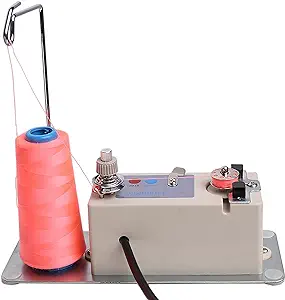
You’ll love the convenience of an automatic electric bobbin winder. This nifty device winds bobbins quickly and evenly, saving you time and frustration.
It’s compatible with various bobbin styles, including A, L, M, Class 15J, and Class 66. The adjustable slot accommodates different bobbin sizes, while the infrared sensor ensures a perfect fill every time.
Just be cautious with plastic bobbins, as they may stick or come off. For best results, use metal bobbins and avoid direct sunlight to prevent motor issues.
It’s a game-changer for your sewing routine!
Best For: Sewers who want to save time and frustration winding bobbins.
- Compatible with various bobbin styles
- Adjustable slot accommodates different bobbin sizes
- Infrared sensor ensures a perfect fill every time
- May not be compatible with all bobbins
- Plastic bobbins may stick or come off
- May cause "dead motor" problem if operated in direct sunlight
4. Simplicity Sidewinder Bobbin Winder
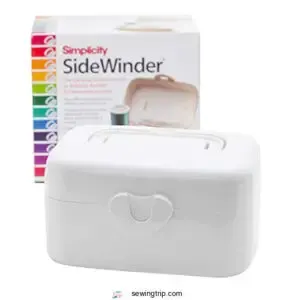
The Simplicity Sidewinder Bobbin Winder is a game-changer for your sewing setup. This nifty gadget winds bobbins quickly and evenly, saving you precious time. It’s compatible with most bobbin types, except for a few specific models.
Running on 120V or two AA batteries, it’s both versatile and portable. The automatic shut-off feature guarantees perfectly wound bobbins every time.
While it may feel a bit flimsy, don’t let that fool you – it’s a functional must-have for any sewer. Just be prepared for a slight learning curve when removing bobbins from the spindle.
Best For: Sewers who value efficiency and ease of use.
- Winds bobbins quickly and evenly
- Versatile and portable with 120V and battery options
- Automatic shut-off ensures perfectly wound bobbins
- Feels a bit flimsy
- Bobbins can be hard to remove from the spindle
- No off button, only an on button
5. Shark Cordless Handheld Vacuum Pet Pro Plus
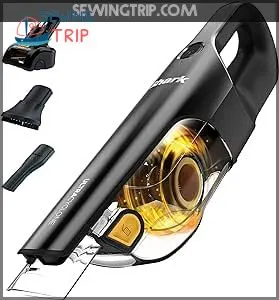
While not a direct bobbin holder replacement, the Shark Cordless Handheld Vacuum Pet Pro Plus can be a game-changer for your sewing space. You’ll appreciate its powerful suction, perfect for cleaning up thread snippets and fabric debris.
Its detachable Pet Power Brush prevents hair wrap, ideal if you’ve got furry friends around. At just 2.8 lbs, you won’t strain while tidying up.
The washable filter and CleanTouch dirt ejector make maintenance a breeze. With its crevice tool and scrubbing brush, you’ll reach every nook and cranny of your sewing machine.
Best For: Pet owners and those who need a lightweight and portable vacuum for quick cleanups.
- Powerful suction for picking up pet hair and debris
- Detachable Pet Power Brush prevents hair wrap
- Lightweight and easy to maneuver
- Not as effective on thicker pet hair
- Battery life could be longer
- Tip can shatter with repeated use
Frequently Asked Questions (FAQs)
Why wont my bobbin case stay in place?
Bobbin blues bugging you? Check for debris or damage in the case. Confirm it’s properly seated and aligned with the machine’s mechanism. Clean thoroughly, lubricate if needed, and verify you’re using the correct bobbin type for your model.
Why does my bobbin case keep popping out?
Your bobbin case may be popping out due to improper installation, damage, or debris interference. Check for correct seating, inspect for wear, and clean the area thoroughly. If issues persist, consider replacing the case or seeking professional repair.
Why does my bobbin keep jamming?
Ever wondered why your bobbin keeps jamming? It’s often due to incorrect threading, tension issues, or debris in the bobbin area. Clean your machine regularly, use quality thread, and make certain proper bobbin insertion to prevent frustrating jams.
Why is my bobbin case not spinning?
Your bobbin case may not be spinning due to thread jams, debris buildup, or mechanical issues. Check for tangled thread, clean the area thoroughly, and make certain the bobbin’s properly seated. If problems persist, consult your machine’s manual or a technician.
Can a Janome Sewing Machine bobbin holder cause problems?
Did you know that 80% of sewing machine issues stem from bobbin problems? Your Janome’s bobbin holder can indeed cause trouble. It might be misaligned, damaged, or dirty, leading to skipped stitches, thread nests, or tension issues.
How do you use a bobbin holder on a Janome machine?
Insert the bobbin into the holder, ensuring it rotates counterclockwise. Place the holder in the machine’s bobbin case, aligning the notch with the spring. Snap it in place, then thread the bobbin through the guide slots.
How to fix bobbin thread not fitting properly on Janome Sewing Machine?
Check your bobbin’s size and brand compatibility. Clean the bobbin case, removing lint and debris. Make sure proper threading and tension. If issues persist, adjust the bobbin tension screw slightly. Regular maintenance keeps your Janome running smoothly.
Why is my Janome machine not working?
Your Janome machine mightn’t be working due to various issues. Check the bobbin case, thread tension, and needle. Clean the machine thoroughly, ensuring all parts are properly seated. If problems persist, consult your manual or a technician.
How to wind a bobbin on a Janome Sewing Machine?
Don’t fret about visual aids; winding a bobbin‘s straightforward. Place thread on spool pin, guide it through tension disc, and wrap around bobbin. Insert bobbin, push winder to right, and press foot pedal. Machine’ll stop when full.
What is a Janome bobbin case?
A Janome bobbin case is a crucial component of your sewing machine. It’s a small, round metal holder that houses the bobbin, controlling thread tension and ensuring smooth stitching. You’ll find it beneath the needle plate.
Can a non-Janome bobbin holder fit my Janome machine?
You might think any bobbin holder will suffice, but that’s not the case. While non-Janome holders can fit, they’re not recommended. You’ll risk damaging your machine or compromising stitch quality. Stick with Janome-specific holders for desirable performance.
How often should I replace my Janome bobbin holder?
You should replace your Janome bobbin holder when it shows signs of wear or damage. Typically, with proper care, it’ll last for years. Regular cleaning and inspection can extend its life. If you’re experiencing stitching issues, consider replacement.
Why does my bobbin holder make a clicking sound?
Did you know 90% of sewing machine issues stem from bobbin problems? Your bobbin holder’s clicking sound could indicate misalignment, debris, or wear. Check for loose parts, clean thoroughly, and make sure the installation is correct. If persistent, consult a technician for expert diagnosis.
Can a damaged bobbin holder affect stitch quality?
Yes, a damaged bobbin holder can notably impact stitch quality. You’ll notice uneven tension, skipped stitches, or thread bunching underneath. It’s essential to inspect your holder regularly and replace it if you spot any wear or damage.
Is it possible to repair a cracked bobbin holder?
Picture a bobbin holder shattering like glass! While repairing a cracked one’s tricky, you’re not out of luck. Try using epoxy adhesive for minor cracks, but for severe damage, it’s best to replace the holder entirely. Don’t risk your stitches!
Conclusion
Mastering your Janome bobbin holder problems is key to achieving seamless, professional results. By understanding common issues, implementing proper maintenance, and utilizing the right tools, you’ll keep your machine running smoothly.
With these tips in hand, you’re well-equipped to tackle any Janome bobbin holder problems that come your way, ensuring your sewing projects are always a stitch above the rest.

